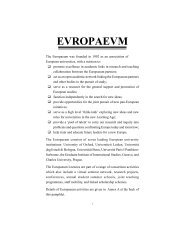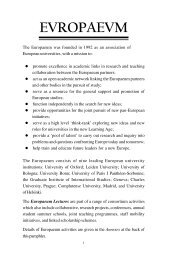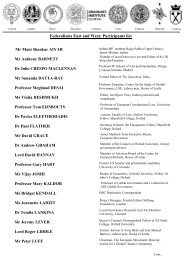to download a Special Report of this meeting - The Europaeum
to download a Special Report of this meeting - The Europaeum
to download a Special Report of this meeting - The Europaeum
Create successful ePaper yourself
Turn your PDF publications into a flip-book with our unique Google optimized e-Paper software.
Anglo-American and European Models<br />
SESSION III<br />
Which Model Works Better Contrasting Anglo-American and European Models<br />
Pr<strong>of</strong>essor Colin<br />
Mayer<br />
Peter Moores<br />
Pr<strong>of</strong>essor <strong>of</strong><br />
Finance, Saïd<br />
Business School,<br />
University <strong>of</strong><br />
Oxford<br />
<strong>The</strong>re is considerable<br />
debate on <strong>this</strong> subject,<br />
taking as its<br />
background the observation<br />
that there appear, at<br />
least superficially, <strong>to</strong> be<br />
significant differences<br />
across countries in terms<br />
<strong>of</strong> the structure <strong>of</strong> their<br />
corporations and the way in which corporations<br />
are governed. At one end <strong>of</strong> the spectrum is the<br />
“Continental European model,” which is actually<br />
is applicable <strong>to</strong> most countries in the world, in<br />
which ownership is dominated by large shareholders<br />
or blocks <strong>of</strong> shares held by particular<br />
inves<strong>to</strong>rs. Graph 1 below records the holdings in<br />
excess <strong>of</strong> fifty percent in listed companies in a<br />
variety <strong>of</strong> countries, showing the proportion <strong>of</strong><br />
listed companies in those countries in which<br />
there is a single shareholder which holds more<br />
than fifty percent <strong>of</strong> shares in a company.<br />
<strong>The</strong> graph records that in countries like<br />
Austria, Belgium, Germany and Italy, in more<br />
than fifty percent <strong>of</strong> listed companies there is a<br />
single majority shareholder. In contrast if you<br />
look at the UK, there is a single majority shareholder<br />
in only two percent <strong>of</strong> listed companies; in<br />
the US its about the same.<br />
It is even more striking on Graph 2, if you<br />
look at the proportion <strong>of</strong> companies in which<br />
there is a single shareholder with a minority<br />
blocking control in a company, with more than<br />
twenty-five percent <strong>of</strong> shares.<br />
In continental European countries, in more<br />
than eighty percent or in some cases more than<br />
ninety percent <strong>of</strong> companies there is such a<br />
shareholder, whereas in the UK it is around<br />
about fifteen percent, and in the US it is 5-8 percent<br />
depending on which market you look at.<br />
It is not only in terms <strong>of</strong> the size <strong>of</strong> the shareholdings<br />
that there appear <strong>to</strong> be substantial differences.<br />
It is also in terms <strong>of</strong> the composition,<br />
so in many countries outsides <strong>of</strong> the UK there is a<br />
dominance <strong>of</strong> holdings by families and trusts<br />
holding on behalf <strong>of</strong> families, as in the case <strong>of</strong><br />
Germany, as Graph 3 demonstrates below.<br />
<strong>The</strong> other striking feature <strong>of</strong> <strong>this</strong> graph is the<br />
extent <strong>to</strong> which there are holdings by other companies:<br />
inter-corporate holdings, cross-shareholdings<br />
and pyramid structures by<br />
which companies hold shares in other<br />
companies as a way <strong>of</strong> controlling those<br />
companies lower down in the pyramid.<br />
In contrast in Britain, as we know,<br />
the dominant source <strong>of</strong> shareholding<br />
comes from financial institutions, which<br />
own sixty or seventy percent <strong>of</strong> the<br />
shares in companies.<br />
Graph 4 (below) brings out another feature:<br />
the importance <strong>of</strong> insider-direc<strong>to</strong>r holdings in the<br />
context <strong>of</strong> the UK.<br />
<strong>The</strong>se observations first raise the question <strong>of</strong><br />
<strong>to</strong> what extent are they temporary or are they<br />
likely <strong>to</strong> be eroded over time. In fact, the differences<br />
are very persistent<br />
Since the end <strong>of</strong> the Second World War, the<br />
structure <strong>of</strong> ownership in Canada, Germany,<br />
Japan UK and US the trends we observe <strong>to</strong>day<br />
have existed: the dominance <strong>of</strong> families and corporate<br />
holdings in Germany, dominance <strong>of</strong> corporate<br />
holdings in Japan, and family holdings in<br />
Canada – against the widely held shareholdings<br />
in the UK and the US. Things may be changing<br />
now, but at least those structures have persisted<br />
for an extended period.<br />
<strong>The</strong> questions that we ought <strong>to</strong> raise in <strong>this</strong><br />
session are, first <strong>of</strong> all, what (if anything) is the<br />
significance <strong>of</strong> these differences Do they matter<br />
in terms <strong>of</strong> corporate governance and the performance<br />
<strong>of</strong> corporations Do we prefer one system<br />
<strong>to</strong> another Is it the fact that these systems<br />
are changing an indication that we are converging,<br />
and is the widely-held view that we are converging<br />
on an Anglo-American structure or<br />
should be converging on an Anglo-American<br />
structure, the correct one What role will different<br />
players, in particular financial institutions,<br />
play as these governance structures change<br />
To address these questions we have a group <strong>of</strong><br />
very well qualified people <strong>to</strong> talk on <strong>this</strong> subject.<br />
Our first speaker is An<strong>to</strong>nio Borges who is a Vice<br />
President at Goldman Sachs and a Chairman <strong>of</strong><br />
the European Corporate Governance Institute,<br />
which is a body which brings <strong>to</strong>gether academics<br />
and practitioners across Europe and in the<br />
United States from both the law and an economics<br />
and finance background <strong>to</strong> address corporate<br />
governance issues. Before that, An<strong>to</strong>nio was the<br />
31
















